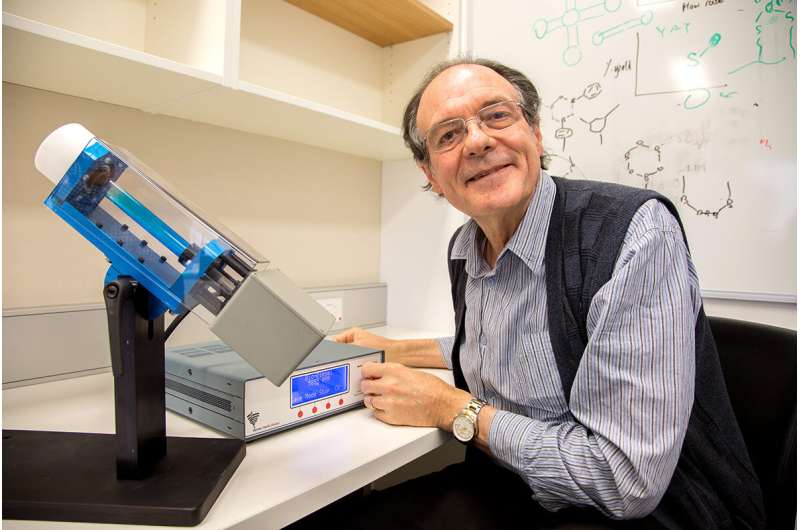Wider applications for the 'unboil an egg' machine

Wider clean chemistry applications of the extraordinary Vortex Fluidic Device—invented by Flinders University's Professor Colin Raston—are likely in the wake of new research that has been published outlining the seemingly endless possible uses.
The defining paper on understanding fluid flow in the Vortex Fluidic Device has just been comprehensively explained in an article published in Nanoscale Advances.
This took more than 100,000 experiments to work out—and Professor Raston hopes this publication will encourage more researchers to embrace the VFD and explore yet more innovative applications for this ingenious device.
"How fluid flows is one of the grand challenges of science," says Professor Raston. "What we have been doing with the VFD provides answers for liquids subjected to mechanical energy."
Since 2013, Professor Raston has been working with his team to explore the possibilities of the VFD, which is capable of controlling chemical reactivity, materials processing and probing the structure of self-organized systems, enabling rapid and now predictable modifications.
The VFD has shown its capability in the synthesis of esters, amides, ureas, imines, alpha-amino phosphates, beta-Keto esters, modified amino acids and the local anaesthetic, lidocaine.
Professor Raston says the high-tech, yet simple device can be used in medical and pharmaceutical research, food processing, materials processing and more, aligned with a range of industries—all with a focus on cleaner, greener and cheaper production—and he hopes that the new conclusive summaries about the VFD experiments will see it embraced by more research organizations around the world, and be taken up by industry.
"The topological fluid flows, which were established as 'spinning top' flow, double helical flow and specular flow, account for all the processing outcomes and applications of the VFD—this is an exciting discovery," says Professor Raston.
"We have established the topological features of high shear fluid flow in the vortex fluidic device at sub-micron dimensions, at a critical tilt angle of 45 degrees, being the optimal angle for myriad applications of the device."
The proposed flow patterns in the VFD provide insights that allow accurate prediction and control the formation of nanostructures in the VFD and chemical reactions. The flow patterns also provide an understanding of the advantages of VFD processing relative to using other methods, showing the VFD processing to be without precedent.
As the latest example of green chemistry innovation, Ph.D. candidate Matt Jellicoe has led research into using the VFD to control the coating of particles without using other waste generating reagents.
The paper, "High shear spheroidal topological fluid flow induced coating of polystyrene beads with C60 spicules," by Matt Jellicoe, Kasturi Vimalanathan, Jason Gascooke, Xuan Luo and Colin Raston, has been published by Royal Society of Chemistry's ChemComm.
"I believe the outcome of this research to be significant because we demonstrate the coating of particles 2-6 microns in diameter with zero waste and up to 98% efficiency. This could be beneficial towards the pharmaceutical companies which coat drugs with significant lower yield, thus leading to run off of dangerous chemicals into freshwater streams and the air," says Mr Jellicoe.
He expects the next stage of testing will investigate the possibility of using the VFD as a drug-coating device.
"This may significantly reduce the effects on the environment," says Mr Jellicoe, "and this is what excites me the most. The potential impact, especially on the environment and the economy, could be unfathomable."
More information: Thaar M. D. Alharbi et al, Sub-micron moulding topological mass transport regimes in angled vortex fluidic flow, Nanoscale Advances (2021). DOI: 10.1039/D1NA00195G
Journal information: Chemical Communications
Provided by Flinders University




















